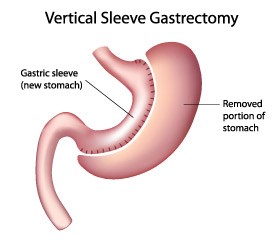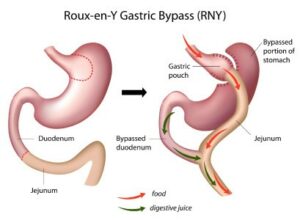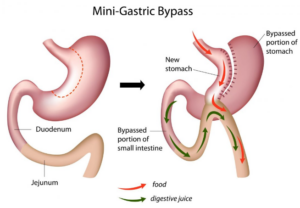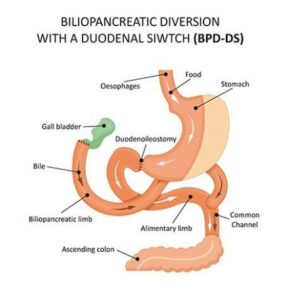Types of Weight Loss Surgery
The aim of weight loss surgery is to reduce weight and control metabolism, helping the patient in achieving their weight loss targets and aiding in the resolution of their weight related medical conditions such as sleep apnoea, high blood pressure, diabetes amongst others. Whilst they are all performed via ‘Key-hole’ (Laparoscopic) surgery, they are all still considered major operations although compared to other major surgery operations, the complication rates are considerably lower. After all of the following procedures, the patient will be required to take lifelong multi-vitamin and mineral supplements. The choice of procedure depends on a variety of factors and not all are appropriate in all patients. Patients who go through our services and are at a stage to proceed to surgery will have a discussion in clinic with one of our Consultant Bariatric surgeons who will explain the procedures and help the patient decide which procedure is most suitable for that individual.
Excess Weight Loss (%)
60-70%
70-80%
65-75%
Time Frame for Weight Loss
Within 24 months
18-24 months
18-24 months
Long-term Sustainability
Moderate to high
High
Moderate to high
Sleeve gastrectomy (SG)

A Sleeve Gastrectomy (or Gastric Sleeve) removes most of the stomach, leaving it much smaller. After this surgery, your stomach will be about 25-30% of its original size with a width of approximately 2.5-3cm. This helps with weight loss by reducing how much food you can eat and decreasing your appetite. The procedure is permanent and not reversible.
Roux En-Y Gastric Bypass (RYGB) – Gastric Bypass

A Roux En-Y Gastric Bypass (RYGB), often simply called ‘Gastric Bypass’ uses surgical staples to create a small pouch at the top of your stomach, about the size of a golf ball. This pouch is then connected directly to your small intestine (small bowel), bypassing the rest of the stomach. This reduces the amount of food you can eat, making you feel full sooner and helping you lose weight by reducing portion sizes.
One-Anastomosis Gastric Bypass (OAGB) – ‘Mini’ Gastric Bypass
A One-Anastomosis Gastric Bypass (OAGB) often referred to as a ‘Mini’ Gastric Bypass is a simpler modification of the Roux En-Y Gastric Bypass (RYGB), however the rate of complications is the same and the name ‘Mini’ must not be considered to mean a less invasive procedure. The procedure involves creating a stomach pouch slightly longer than in the RYGB and joining it to a loop of small intestines (small bowel). Like in the SG and RYGB, this reduces the amount of food you can eat and reduces the amount of calories that can be absorbed by the bowel.
Duodenal Switch (DS)
The Duodenal Switch (DS) is a more complex procedure, undertaken in patients with a very high BMI. At our hospital, the DS is usually performed in two stages and includes a cholecystectomy (gallbladder removal). It starts with a sleeve gastrectomy to reduce the stomach size and appetite and the second stage reroutes the intestines, similar to a Gastric Bypass. In exceptional circumstances, where patients have previously had a sleeve gastrectomy and have not lost enough weight, it can be offered as a single stage procedure. This would require the relevant funding in place prior to this being offered and you may need to discuss this with your GP and our team.


